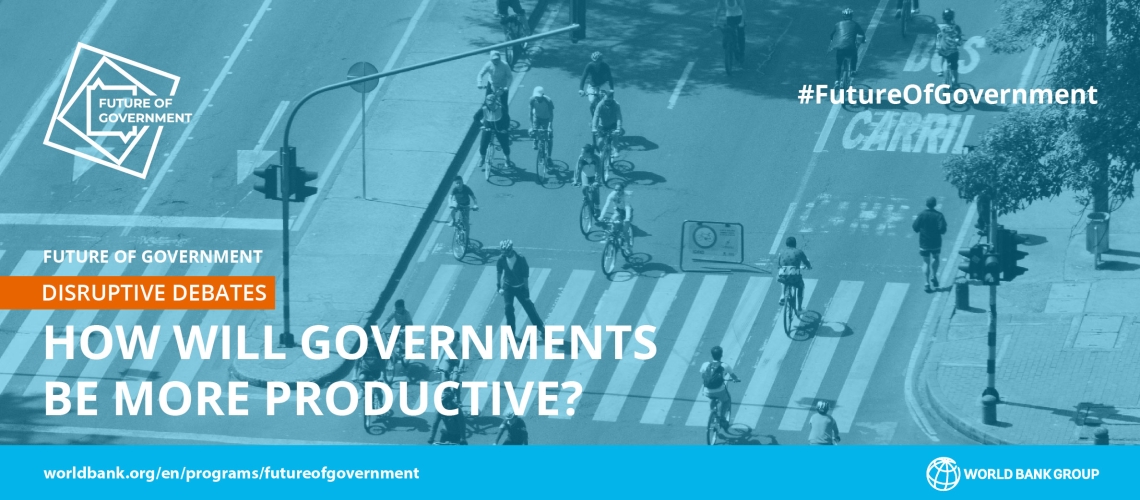How to increase government productivity in the post-COVID-19 world

Future of Government Fourth Disruptive Debate
The fourth Future of Government Disruptive Debate took place Wednesday, September 1st, 2021. It featured participants from around the world and sought answers to the question: How will governments be more productive once the COVID-19 pandemic has ended?
Former U.K. Minister Francis Maude, now chairman of FMA, which advises governments on efficiency and public-sector reform, noted that the pandemic has created three challenges for all governments: the state has become larger; responses have overwhelmed public finances; demands on governments are rising and expectations of citizens on issues such as social protection and climate are increasing.
Responding to the challenges brought on by the pandemic is a question of government productivity. One way to start is by thinking about efficiency, such as the digital transformation in the U.K., where over 15,000 government-run websites were incorporated into a single domain. Many cross-cutting government functions, such as procurement, planning and executing major projects, as well as human resource management are contained in silos and they need to be moved under a center of government to improve productivity.
While most governments can develop policy, they are often less effective in implementation. The underlying – often missing – competencies for implementation and productive government include information and communication technologies, along with budget and project management. Country context is crucial. The critical steps to improve productivity are bespoke and cannot simply be transplanted from somewhere else.
Marta Arsovska Tomovska, Serbia’s director for Public Administration Reform and E-Government, agreed that digital transformation is key to improving productivity, and that it should be undertaken with a keen eye to understanding citizens’ needs. Digitalization is not cheap, but it always pays off. Most importantly, it creates public value in the form of high-quality, low-cost services, and helps to fight corruption.
Governments cannot undertake these changes alone and should look to partnerships and cooperation with non-government actors. Governments can learn from the private sector, including by taking cues from start-ups about speed, agility, and innovation when considering new procedures. Automated decision-making systems across government will mean that some jobs will inevitably be displaced. Yet new ones will be created. In a more productive government scenario, a programmer or coder would sit alongside policymakers. A future-ready government makes policy decisions that are driven by data alongside citizen needs.
Peck Kem Low, chief human resources officer, Singapore Public Service, pointed to Singapore’s vision of a “smart nation” and noted that the future of government is at the center of its planning. Due to its small size, Singapore has no choice but to continuously think of ways to improve both the workforce and the workplace. Technology is critical. Human resources play a central role in driving more efficient public services and they must ensure customers (citizens) are at the center of all technological improvements. Improving government productivity aims to be high tech, yet also high touch.
While copying the Singapore model elsewhere is almost impossible, increasing productivity starts with the workforce. Building agility into the existing workforce and training it for the future is essential. Governments should not only invest in technology, but in people, too. Cutting red tape for government workers, setting achievable targets and measuring progress, and embedding continuous training into government workforce culture are good starting points for any country.
For Francisco Gaetani, former executive secretary of Brazil’s Ministry of Planning, Budget and Management, said bigger countries, including his, must tackle a huge range of problems. Just like in Singapore, information and communication technology is the most significant tool at the government’s disposal to improve productivity. However, it is tough to tackle an established bureaucratic culture and harder to modernize and improve productivity. Upskilling the workforce is a challenge, and the value of productivity is still not a permanent goal embedded in governance. One way to address this might be to bring in greater numbers of young people who are already tech savvy. But this also raises another challenge: What to do with the current, older workforce, which can be difficult to retrain?
Cost-benefit analyses are helpful to review programs for reform, and change does not mean throwing out accountability in a drive for efficiency, especially when there is a history of corruption in the country. Technology can help to tackle both productivity problems and corruption. Training the workforce to accept and use these tools, however, is another matter – behavior change is key.
Concluding the discussion, Edward Olowo-Okere, Director of the World Bank’s Governance Global Practice, noted that the central question underlying government productivity is how to do more with less. Technology is central, as it brings better quality to government services while helping to fight corruption. Any effort to improve government productivity starts with the workforce, and reforming administrative cultures, improving skills and recruitment practices. The next step is measuring productivity gains, while remembering that governments are at various starting points.
How do you think governments can be more productive in a post-COVID world? Let us know below. You can also share your thoughts by answering the poll on the question here.
The replay of the debate is available to watch here.
